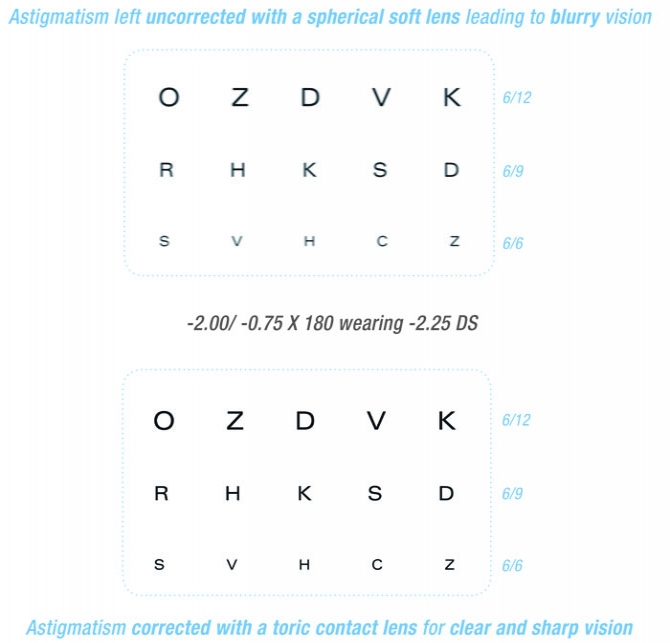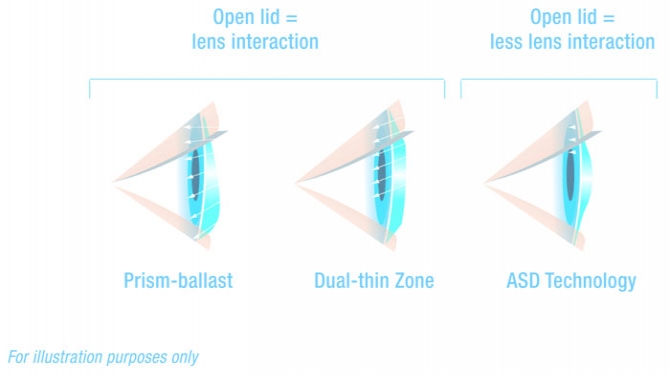Spectacle wearers
A bigger opportunity than you think
Help your patients experience improved peripheral vision and greater detail in their world.1
Make it happen. Initiate the conversation
Patients rely on you for information about vision correction alternatives. Do your patients understand what astigmatism is? The concept can be difficult to grasp and simple explanations can often help.
Reassure them that they are not alone – astigmatism is a common condition that affects around half of the population.2
Emphasise a specific individual solution
Toric lenses exist for all types of astigmatism, including low or monocular, and combined with short or long sightedness.
Inspire them with detailed vision
ACUVUE® Brand Contact Lenses for ASTIGMATISM provide visual acuity as good as spectacles, enabling your patients to capture every detail around them.1
Reassure them about comfort, and what to expect
73% of spectacle wearers said ACUVUE® Accelerated Stabilisation Design contact lenses felt much or somewhat better than their expectations.3
Introduce them to easy handling
ACUVUE® Accelerated Stabilisation Design contact lenses are rated easy to put in and take out by spectacle wearers who trial them.4
Offer them healthy, flexible lifestyle choices
All ACUVUE® contact lenses have high levels of protection from the transmission of UV.*
ACUVUE® Accelerated Stabilisation Design contact lenses provide flexibility with two-weekly replacement reusable or daily disposable modalities to offer the health benefits of frequent replacement.
*All ACUVUE® Brand Contact Lenses have Class 1 or Class 2 UV-blocking to help provide protection against transmission of harmful UV radiation to the cornea and into the eye. UV-absorbing contact lenses are NOT substitutes for protective UV-absorbing eyewear such as UV-absorbing goggles or sunglasses because they do not completely cover the eye and surrounding area.
- Sulley A, Young G, Lorenz K & Hunt C. Clinical evaluation of fitting toric soft contact lenses to current non-users. Ophthalmic Physiol Opt 2013, 33, 94–103.
- Young G, et al. Prevalence of Astigmatism in Relation to Soft Contact Lens Fitting. Eye and Contact Lens 2011; 37 (1): 20–25. Prevalence of astigmatism >0.75DC in at least one eye is 47%.
- JJVC data on file 2011; Randomised, bilateral study for 1 month daily wear; with astigmatic spectacle wearers (with neophytes and drop outs), N=114; 73% of specs wearers said that trying this CL felt much better/ somewhat better than expectations.
- JJVC data on file 2011. Randomised, bilateral, open label, 1-month DW multi-centre study. With astigmatic spectacle wearers (with neophytes and drop outs), N=114; respectively 72% & 76% of specs wearers said ASD lenses were easy/ very easy to put in & to put out.
Lapsed wearers
A better contact lens experience
If your patient has had a poor experience with contact lenses previously, which resulted in discontinued use, explain to them that not all toric contact lenses are the same and that technology has improved greatly with the latest generation of contact lenses.
Useful questions:
- Was your vision as good as with your spectacles?
- Did you experience any change in your quality of vision? (e.g. during extreme gaze or when lying down)
- Did comfort vary throughout the day?
Comfort is a major factor in contact lens drop out1
Talk to patients about comfort technologies specifically designed to help keep eyes feeling moist and fresh at the end of the day, even in challenging environments2,3
- HYDRACLEAR® PLUS and LACREON® with built-in wetting agents that do not blink away, deliver excellent comfort and retain moisture2,3,4,5
- Accelerated Stabilisation Design Technology delivers clear and stable vision throughout the day, however active patients' lifestyles may be.6,7,8
- TNS VisionTrak Panel consumers UK, France, Germany, Italy 2007. 32% consumers stop wearing lenses due to discomfort and 26% due to dryness.
- Young G et al. Hydrogel Lens Comfort in Challenging Environments and the Effect of Refitting with Silicone Hydrogel Lenses. Optom Vis Sci (2007); 84(4): 302-308.
- JJVC data on file, 2010. Randomised, subject-masked, bilateral, cross-over dispensing study, 1 week DW, with habitual soft toric lens wearers. N=67, Feeling Fresh and new throughout the day: 1DAMfA 59% find it excellent / very good, P<0.05.
- Sheardown H et al. Wetting Agent Release from daily disposable Toric Lenses. BCLA Poster 2011.
- Jones et al. Multicentre evaluation of two silicone hydrogel toric contact lenses. CLAE 2009 32;5: 210-254.
- Chamberlain P et al. Fluctuation In Visual Acuity During Soft Toric Contact Lens Wear. Optom Vis Sci 2011; 88: E534-538.
- JJVC data on file 2010.
- McIlraith R et al. Toric lens orientation and visual acuity in non-standard conditions. CLAE 2010; 33 (1): 23-26.
Spherical wearers
An engaging way to improve their vision
During a routine check-up, it can be useful to advise astigmats wearing spherical contact lenses that they can achieve significantly superior visual acuity with ACUVUE® Accelerated Stabilisation Design toric contact lenses.1
Engage them in the idea of improving their vision

Quick and easy to fit
- High fit success: ACUVUE® Accelerated Stabilisation Design contact lenses are as easy to fit as spherical lenses2
- Fast and easy fitting giving you the same confidence as when fitting a spherical lens1,2,3
- 85% lenses orientated within ±5° of zero position after a three-minute settling1
- First fit success: 95%2,3
- Sulley A, Young G, Lorenz K & Hunt C. Clinical evaluation of fitting toric soft contact lenses to current non-users. Ophthalmic Physiol Opt 2013, 33, 94–103.
- JJVC data on file 2008 and 2009 for AOfA.
- JJVC data on file 2010 for 1DAMfA, based on subjective refraction; 100% physical fit success; randomised, subject-masked, bilateral, cross-over dispensing study, 1 week DW, with habitual soft toric lens wearers. N=67.
Toric wearers
Discover their life beyond the chair
Make sure current toric wearers are really satisfied with their lenses and let them know all contact lenses are not the same.
Ask about their vision in extreme gaze or with their head tilted, and question them about relevant hobbies and activities.
Key questions to ask:
- Is your vision clear and stable throughout the day?
- How is your vision when moving your eyes or in extreme gaze (eg driving or playing sport)
- Did you feel the same level of comfort throughout the day?
Different toric lens designs may result in different vision experiences
It's important to clarify the differences between toric lens designs. Accelerated Stabilisation Design (ASD) Technology is only found in ACUVUE® contact lenses for ASTIGMATISM. Its four stabilisation zones deliver clear and stable vision throughout the day with minimal impact from eye or head movements, however active patients' lifestyles may be.1,2,3
- Accelerated Stabilisation Design has minimal variation of lens thickness under both eyelids which helps maintain clear and stable vision regardless of eye movements1,2
- Accelerated Stabilisation Design is less influenced by gravity so your patients can experience clear and stable vision regardless of their physical activities and head movements2,3

- Chamberlain P et al. Fluctuation In Visual Acuity During Soft Toric Contact Lens Wear. Optom Vis Sci 2011; 88: E534-538.
- JJVC data on file 2010.
- McIlraith R, Young G, Hunt C. Toric lens orientation and visual acuity in non-standard conditions. CLAE 2010; 33 (1): 23-26.


